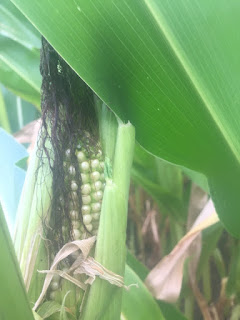This is largely down to my urban and city upbringing which gives a sense of fear and suspicion of anything unknown, or, in this case of a rural orientation. There is also the risk of being chased off by the farmer or worse.
It has only been noticeable to me in that last few years that maize has been more extensively, commercially grown in my local area and so opportunities prior to this to stand amongst it have tended to be pretty far and few between.
Oh, and there is the strong association of this particular crop with things sinister, foreboding and downright scary in that it has featured in popular cinema and culture as a favourite hiding place for alien beings (Signs 2002),as the power house for forces of nature (Twister), a location for crude chase and peril (Wild Wild West 1999) and a Kevin Costner movie, Field of Dreams.
Even in made for TV features it is invariably in a field of maize that a crime is committed, a body found or a tension created that promises an edge of seat or behind the sofa cushions type experience.
This irrationality of mine has prevented me from appreciating the wonders of maize, that is, until today when I got up close and without anxiety or fear of bodily harm was able to study in detail the specific features of what is, after all, one of the most widely farmed crops globally, in fact it can be found on every continent apart from Antarctica.
For all of its wild appearance the plant does not grow naturally, it is actually entirely down to having been cultivated by humans.
Aside from the marketing persona of The Jolly Green Giant in getting us to eat sweetcorn, a part of the corn plant's flower, there are over 4000 different uses for corn and it can be found in the manufacturing processes of cola, ketchup, peanut butter, hot dogs, chewing gum, ice cream, paint, explosives, matches, batteries, soap and even crayons.
Maize was a staple in the diet of ancient civilisations and archaeologists have been able to take 1000 year old corn and make it into popcorn as an indicator of the sheer resilience of the crop.
It is a very distinctive plant from its strong, almost bamboo size and textured stem to broad waxy leaves, tight flower pod from which the cob sprouts and a spiny quality to protect it from its natural enemies of birds, insects and rodents.
You can see how it has become a favourite mood and atmosphere creator in art, culture and movies as it does have its own worldly and yet somewhat extraterrestrial characteristic.
I just had to finish on this photo, the last one I took before I ran, in a panic out of that field and to safety. I think I heard a crow call my name.......................................................................................








No comments:
Post a Comment